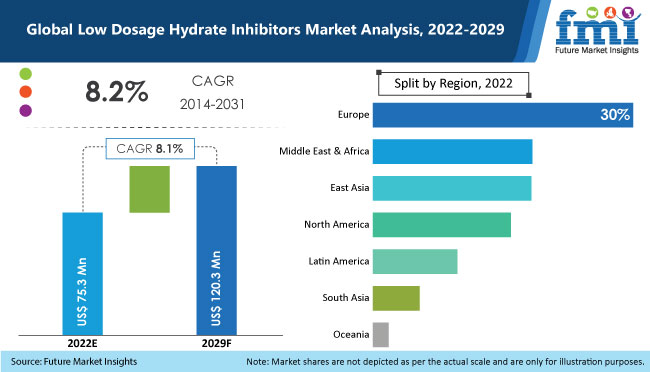
Global consumption of low dosage inhibitors is likely to increase at a robust pace over the course of forthcoming years. Future Market Insights (FMI) recently published a new research study titled – ‘Low Dosage Hydrate Inhibitors Market: Global Industry Analysis 2013–2021 and Opportunity Assessment 2022–2029′. The report has projected the global low dosage hydrate inhibitors market for an impressive 8.1% CAGR between 2022 and 2029.
| Attribute | Details |
| Low Dosage Hydrate Inhibitors Market Estimated Size in 2022 | US$ 75.3 Mn |
| Low Dosage Hydrate Inhibitors Market Value-based CAGR (2022-2029) | ~8.1% |
| Low Dosage Hydrate Inhibitors Market Projected Size in 2029 | US$ 120.3 Mn |
Application of low dosage inhibitors will be particularly high in the offshore terrain segment, according to FMI’s analysis. Estimated to achieve a massive incremental opportunity through 2028, more than 90% of overall consumption of low dosage hydrate inhibitors is expected to be registered by offshore terrain.
Anti-agglomerate Inhibitors Hold Potential to Rise above Kinetic Hydrate Inhibitors
A majority of leading manufacturers have been accelerating the shift from the conventional thermodynamic inhibitors to low dosage hydrate inhibitors in an effort to achieve significant savings in terms of maintenance costs. Increasing acceptance of low dosage hydrate inhibitors will be further strengthened by cost benefit related to flow assurance and flow maintenance, storage, logistics, and pumping among others.
Request a sample to obtain authentic analysis and comprehensive market insights at- https://www.futuremarketinsights.com/reports/sample/rep-gb-1298
In addition, the BOD (biological oxygen demand) and COD (chemical oxygen demand) associated with low dosage hydrate inhibitors is significantly lesser than that with thermodynamic inhibitors. According to FMI’s study, superior sustainability quotient will continue to place low dosage hydrate inhibitors superior to thermodynamic inhibitors. In line with the increasing quest of sustainability, anti-agglomerate type of low dosage hydrate inhibitors, which are more degradable than kinetic hydrate inhibitors, will remain the most preferred compound in the global low dosage hydrate inhibitors market.
China to Remain Dominant Producer & Consumer of Low Dosage Hydrate Inhibitors
China is expected to lead the overall low dosage hydrate inhibitors’ consumption, retaining the title of the largest producer and consumer of low dosage hydrate inhibitors, globally. North America accounted for more than 16% of the total revenues attained by global low dosage hydrate inhibitors in 2018. The report envisages that North America will remain among the most important markets for low dosage hydrate inhibitors throughout the period of study. Furthermore, this growth is primarily attributed to the region’s primacy in offshore gas production activities.
Although the report reaffirms supremacy of China and North America in the low dosage hydrate inhibitors landscape, the flourishing manufacturing scene in fast-developing regional pockets such as East Asia, MEA, and Latin America prompt at the speeding revenue growth of low dosage hydrate inhibitors.
Consistently growing demand for low dosage hydrate inhibitors from emerging markets such as India and ASEAN countries is expected to create ample opportunities for the manufacturers of low dosage hydrate inhibitors in coming years. New offshore natural gas exploration projects are further expected to boost the consumption levels of low dosage hydrate inhibitors in MEA, through 2028.
Vendor Insights: Global Low Dosage Hydrate Inhibitors Market
The report has covered detailed strategic profiles of some of the top companies operating in the global low dosage hydrate inhibitors market, such as BASF SE, Schlumberger Limited, Arkema Group, Baker Hughes Incorporated (BGHE), Clariant AG, Ecolab Inc., Evonik Industries AG, Force Chem Technologies LLC, Halliburton Co., and Gas Hydrate LLC, among others.
Get Customization on This Report for Specific Country – https://www.futuremarketinsights.com/customization-available/rep-gb-1298
Low Dosage Hydrate Inhibitors Market by Category
Product Type:
- Anti-agglomerate (AA) Inhibitors
- Kinetic Hydrate Inhibitors (KHIs)
Terrain Type:
- Onshore
- Offshore
Region:
- North America
- Latin America
- Europe
- Oceania
- East Asia
- South Asia
- Middle East & Africa (MEA)
Table Of Content
1. Executive Summary
1.1. Global Market Outlook
1.2. Demand Side Trends
1.3. Supply Side Trends
1.4. Technology Roadmap
1.5. Analysis and Recommendations
2. Market Overview
2.1. Market Taxonomy
2.2. Market Definition
3. Key Market Trends
3.1. Key Trends Impacting the Market
3.2. Development Trends
3.3. Porter’s Analysis
4. Key Success Factors
4.1. Product Adoption Rate
4.2. Technology Adoption Rate
4.3. Strategic Promotional Strategies
5. Market Background
continued…!
Key Questions Answered in the Report
What is the global low dosage hydrate inhibitors market size?
At what rate did the global low dosage hydrate inhibitors market grow between 2013 and 2021?
What are the key trends boosting sales of low dosage hydrate inhibitors?
Who are the leading low dosage hydrate inhibitors market players?
What is the share of North America in the global low dosage hydrate inhibitors market?
What is the East Asia low dosage hydrate inhibitors market outlook?
About FMI
Future Market Insights (ESOMAR certified market research organization and a member of Greater New York Chamber of Commerce) provides in-depth insights into governing factors elevating the demand in the market. It discloses opportunities that will favor the market growth in various segments on the basis of Source, Application, Sales Channel and End Use over the next 10-years.
Contact Us:
Future Market Insights
Unit No: 1602-006
Jumeirah Bay 2
Plot No: JLT-PH2-X2A
Jumeirah Lakes Towers
Dubai
United Arab Emirates
LinkedIn| Twitter| Blogs
